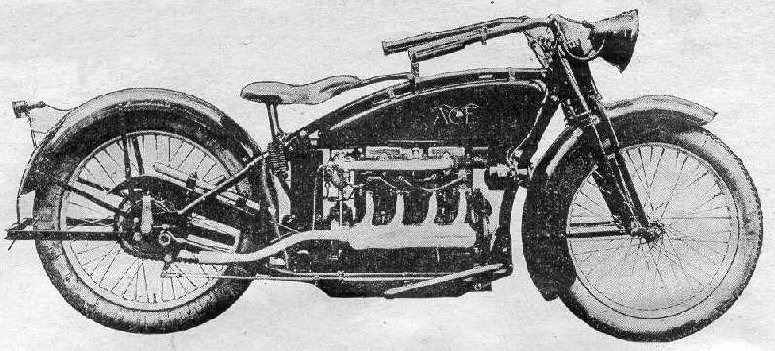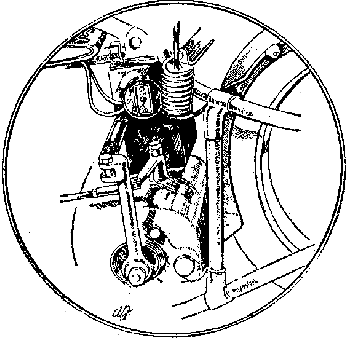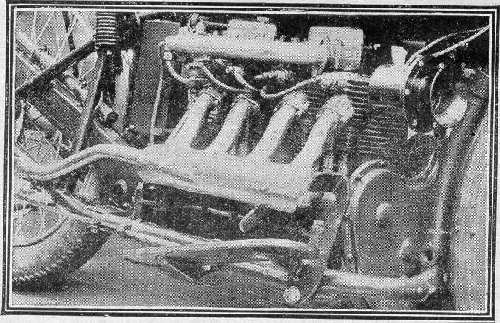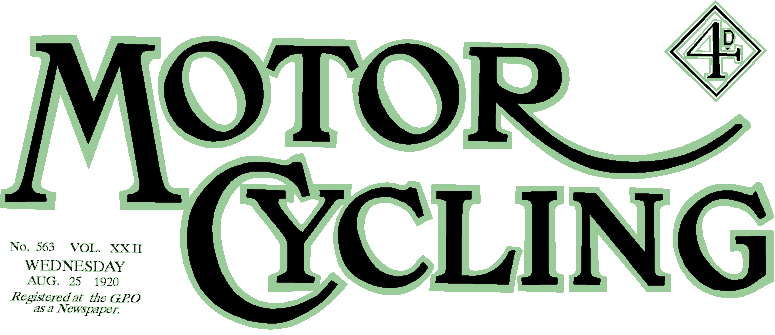 |
| Compactness and a remarkably low riding position
are outstanding features of the Ace |
THE ARRIVAL OF THE FOUR-CYLINDER ACEAmericas Latest "Four". Several Interesting Innovations |
| The first consignment of Ace four- cylinder motorcycles to be
despatched to these shores has now arrived. This was unloaded at
Liverpool a few days ago, and judging by the interest caused by our
recent references to the four-cylinder ’engine, we should say that the
moment chosen to introduce this newcomer to the British market; is an
exceedingly propitious one. We have been permitted to inspect the Ace by
the courtesy of Melchoir Armstrong and Deseau, Great Marlborough Street,
W., the sole distributor, in whose showrooms a sample machine was on
view during the latter end of last week.
A Superficial Resemblance to an Existing Machine.It, is, we believe, fairly generally known that the Ace has been
designed by Mr. W. G. Henderson, who brought out the four-cylinder
machine bearing his name about nine years ago, and who has already won
high honours in a highly specialized field. Perhaps it might be said
that in designing the Ace Mr. Henderson did not forget old associations,
but the resemblance is really only superficial, and, more or less,
begins and ends at the frame, which is of the cradle pattern with
special truss stays connecting the back forks and "chain
The four-cylinder engine is set in line with the frame is a type of construction which lends itself admirably to unit design of engine and gearbox, and in the Ace full advantage is taken of the possibilities of this system. - It is a true power and transmission unit, comprising as it does engine, clutch, gearbox, magneto, and lubrication. system. The engine is of the rapidly growing class known as "oversize "; it has a piston displacement of 75 cubic ins., and therefore comes outside the 1,000 c.c. limit, the equivalent of which is 68 cubic ins. The actual bore and stroke are 2.7 ins. by 3.25 ins., and the nominal rating is 20 ’h.p. American designers appears to regard the increase of capacity with some degree of favour, as most manufacturers have produced engines of this size, but it remains to be seen whether English concerns will follow suit, or whether they will decide that the present limit of 1,000 c.c. is enough for any conditions likely to be encountered over here. 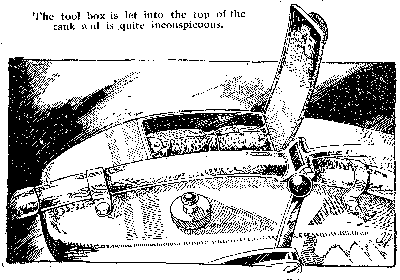
Despite the comparatively small size of the cylinders, the engine is a remarkably robust; piece of work, the design following car lines very closely. Evidence of this is found. in a striking manner in the layout of the crankshaft, which is carried in three bearings of generous dimensions, lined with anti-friction metal. The big-end bearings are of the same type, and are, of course, split to allow of adjustment. In order that very large valves may be used, and to reduce the pocket area-as far as possible, the inlet valves are carried over the exhaust, and a very valuable feature is the enclosing of the former in covers. Too often do we see valve mechanism of this type quite unprotected, with the result that lubrication is difficult, grit finding its way’ into the rocker arm -bearings shortening their life considerably. The Ace covers appeal to us as being a really good thing, as, apart from the protection they afford, they have a hinged lid. at the top which, on being lifted, reveals a small oil reservoir with six holes leading to the rocker arms. The operation of oiling being reduced to its simplest possible form – all that is required is to fill this reservoir up at stated intervals – removes one of: the chief causes of rapid wear of the valve mechanism – insufficient lubrication. Designers would do well to bear in mind the fact that adequate maintenance depends less on the question of attention than on the provision made for ensuring that the time spent on giving attention will give 100 per cent results. A Detail which Ensures Efficiency.The sparking plugs are placed in the valve pocket, in such a position that they function in a, spot which normally will be charged with gas accessibility at this point has not been overlooked. 
The carburettor is the familiar, Schebler automatic, and the arrangements made for utilizing the exhaust gases for the purpose of thoroughly atomising the fuel are remarkably complete. The induction manifold itself is exhaust jacketed through the agency of a lead from the rear exhaust union, and the main air supply to the carburettor is derived from a pipe which runs the whole length of the expansion chamber; consequently this supply is pre-heated. The induction manifold itself is interesting, as the charge does not, as might appear at first sight reach rear cylinder first. sight, reach the rear cylinder first. Were this the case it is obvious that the remaining cylinders would. be starved progressively. Actually,- there is a wall inside the manifold, which extends to a point- about midway between the two valve inlets. On entering the manifold the gas, follows along this wall to the central point, when it travels an equal-- distance to each intake, which prevents one set of cylinders receiving more fuel ’ than the other. Engine Repair and Adjustment Made Easy.At the forward end of the engine is the timing gearcase, which
contains a train of wheels, which operate the camshaft and magneto drive
shaft. Attention should be called at this point to the fact that the
bottom ha1f of the crankcase can be removed. without disturbing any
other part of the engine. This is a valuable feature, which allows easy
access to all the working parts, an6 it would be possible to take up
wear in the big-end bearing by this means. This removable underpan is,
in fact, the sump, and. attached to it is a metal plate, which - runs
almost the whole length, in which are formed depressions, or troughs,
into which the big-ends dip for the purpose of lubrication. This sump is
ribbed on the under side as a means of cooling the oil, which is kept in
a constant state of circulation, and is pumped into the troughs by means
of a gear-type pump, which is undoubtedly the simplest possible form
that could be employed, as there are no valves or plungers. After the
oil has done its work it is. conducted. , back to the sump to be used
over again. While - there is nothing revolutionary in the. design of the three-speed gearbox, which is of the orthodox type, top and .. low gears being engaged through the agency of dogs, with a, slidinig pinion for second speed, the method of locking the various gears in position is somewhat unusua1. The mechanism for ’effecting this is contained within the gearbox, and consequently there are no matches on the gear lever quadrant itself. Gear change therefore will be a matter "feel" and provided the locking mechanism is sufficiently positive to prevent the chance of a particular gear being only in partial engagement, it would appear to have many advantages. The c1utch is of the multiple steel disc type, running in oil , and no adjustment is necessary; in fact, Huge Petrol Capacity.The tank, which contains petrol only, is stated to have a capacity of net 1ess than four gallons,. – and: advantage is taken of the fact that the whole of the oil is carried in the sump to provide inside the tank a tool box with a hinged lid. The bottom of this tool box is padded with felt, and although the space available is not so great as that provided by a pair of pannier bags, it is certainly a convenient method of carrying those tools which are likely to be in most constant use. Both brakes are of the external contracting variety,- the drums being actuated. at opposite ends of the back hub. Operation is effected through the agency of .right . and, left pedals, both conveniently placed, and a further pedal on the left side of the machine actuates the clutch. A long lever working alongside the gear control is an a1ternative method of working the c1utch. It’ is, perhaps, hardly necessary to state that twist grips are utilised. to control the carburettor and ignition. Both of these open inwards, and the power is transmitted through a flexible steel wire. The magneto is a Berling, driven by an independent shaft, on which, in the case of the electrical mode1, is mounted a pulley, over which runs the leather belt which drives the Splitdorf dynamo, The accumulator which forms part of the Splitdorf electrica1 equipment, is carried underneath the saddle cluster, and the necessary switch for contro11ing the lights is carried on the-case itself. A power Klaxon is included in the equipment on the electrical mode1, and in this connec-tion it, may be pointed out that the manufacturers of the Ace have introduced a new expression, " ’horning," as a method of stating that the power necessary to operate the Klaxon . is derived. from the same source which provides the current, for lighting the lampa. The Ace catalogue states that "electric current for lighting and horning is supplied from a storage battery," and we submit that this expression is one that might with advantage be included in the English vocabulary. Not a Cheap Machine.The - Ace will rank as one of the highest-priced machines in this country, as the regular model seeks at £210, with £25 extra for the electric equipment. The machine we inspected ha8 not that exquisite sheen’ on the enamel which one ueual1y associates with American productions, ’but, possibly the fact that it had only been unpacked a few hours prior to our visit may account for this. The finish, according to the makers, is "Packard blue and cream," but to the ordinary unemotional eye it is just plain blue and yellow. While this colour scheme is not actually displeasing, we just admit that we viewed it, with more interest than enthusiasm, and are inclined to think that such a 1ight colour is hardly suitable for rims. The new Ace four-cylinder is a machine which, by reason of its. price,: can only have a very limited clientèle, but as an aristocrat, among motorcycles it easily takes its place with the front rank. To four-cylinder devotees it opens up a fresh opportunity for comparison.
|
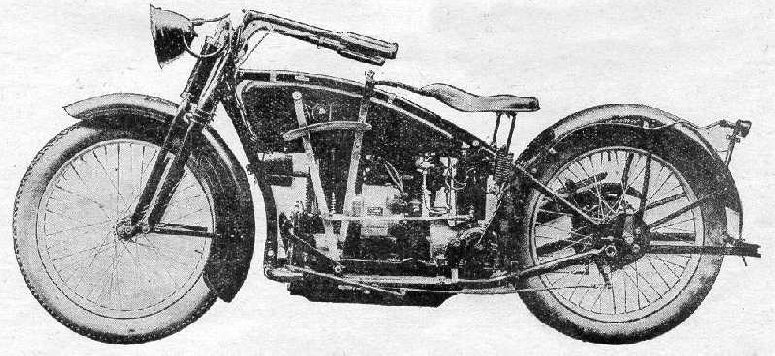 |
|
Rohan Bradney has kindly linked in this Ace article and subpages within his ACE - Resources pages and I thank him for this. This page is reworked and adapted from the original presentation article presented in the British magazine "Motorcycling" as stated in the heading. The pictures are scanned and touched up by me and larger versions and my personal comments can be accessed by clicking on the illustrations. I'll welcome any other comments on this presentation and especially on the 1920 Ace Mortorcycle itself, as I am the happy owner of one. Per Erik Olsen in Hokkåsen, Norway
I |
